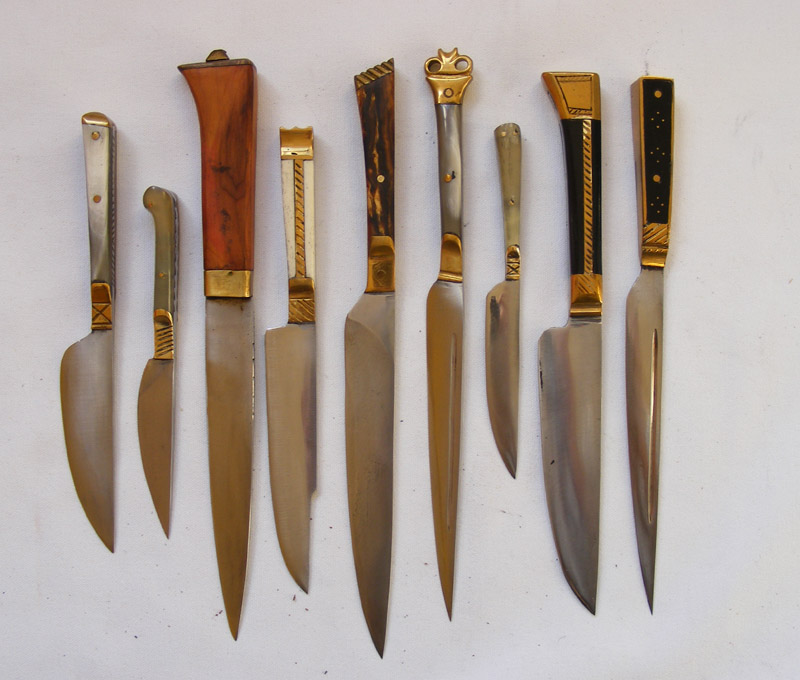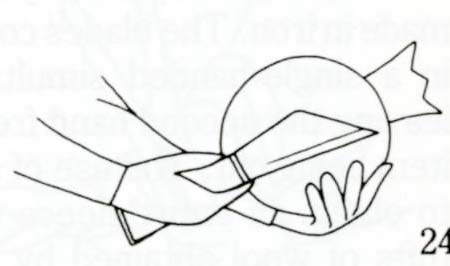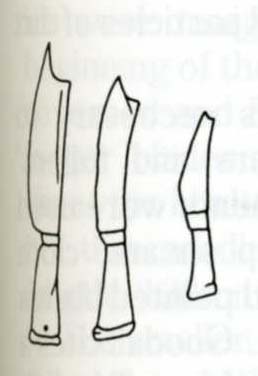| Author |
Message |
Chad Arnow
myArmoury Team


|
 Posted: Thu 05 Aug, 2010 9:50 am Post subject: Fuller pattern question Posted: Thu 05 Aug, 2010 9:50 am Post subject: Fuller pattern question |
 |
|
Hey folks,
I was looking through an old thread, and found a couple of knives that had fuller patterns I don't remember seeing anywhere.

Specifically, the fullers on the 6th and 9th examples. The fullers start and end on the blade. Anyone seen any historical pieces from similar time periods (15th-16th century) that are the same?

ChadA
http://chadarnow.com/
|
|
    |
 |
Artis Aboltins

|
 Posted: Thu 05 Aug, 2010 10:10 am Post subject: Posted: Thu 05 Aug, 2010 10:10 am Post subject: |
 |
|
Hmm, might it be that originally those "fullers" where made to hold a decorative inlay that had fallen off? At least the nr.9 looks surprisingly alike one of my early attempts at inlaying 
|
|
  |
 |
|
Jeremy V. Krause
|
 Posted: Thu 05 Aug, 2010 12:21 pm Post subject: Posted: Thu 05 Aug, 2010 12:21 pm Post subject: |
 |
|
| Artis Aboltins wrote: | Hmm, might it be that originally those "fullers" where made to hold a decorative inlay that had fallen off? At least the nr.9 looks surprisingly alike one of my early attempts at inlaying  |
I would guess not given the time period which I presume to be c. 1400's. Also these seem to be eating knives and I just haven't seen any with an inlaid fuller. My knowledge on this issue is CERTAINLY NOT exhaustive.
Tod will likely chime in soon though.
|
|
  |
 |
Chad Arnow
myArmoury Team


|
 Posted: Thu 05 Aug, 2010 12:32 pm Post subject: Posted: Thu 05 Aug, 2010 12:32 pm Post subject: |
 |
|
| Jeremy V. Krause wrote: | I would guess not given the time period which I presume to be c. 1400's. Also these seem to be eating knives and I just haven't seen any with an inlaid fuller. My knowledge on this issue is CERTAINLY NOT exhaustive.
Tod will likely chime in soon though. |
Inlaid fullers do seem to be more of a 14th century than 15th.
Tod and I have gone back and forth and there is some evidence for similar things. I was just hoping to find more.

ChadA
http://chadarnow.com/
|
|
    |
 |
|
Peter Johnsson
Industry Professional
|
 Posted: Thu 05 Aug, 2010 1:08 pm Post subject: Posted: Thu 05 Aug, 2010 1:08 pm Post subject: |
 |
|
Chad,
In "Knives and Scabbards" you will find several blades with narrow groves along the spine. These can be very narrow indeed. I cannot seem to remember seeing any such blades where the grove does not continue into the grip and stop short of the bolster like on the replicas you posted a photo of.
Sometimes medieval knives can have decorative groves in the spine as well. Groves along the spine are often found on one side only. The "front" of the knife is the one you see if you hold the knife in you right hand with the point away from you and having the edge facing towards you left. It is most often this side that has the smith´s stamp as well. If there are narrow groves they tend to be cut into this "front face" of the blade. False edges may also often be ground only from this side, so that the backside of the knife is flat and unadorned with no bevel from the false edge.
|
|
   |
 |
Chad Arnow
myArmoury Team


|
 Posted: Thu 05 Aug, 2010 2:00 pm Post subject: Posted: Thu 05 Aug, 2010 2:00 pm Post subject: |
 |
|
The Museum of London book Knives and Scabbards has two line drawings of period art that suggest fullers that stop short of the bolster. Of course, not seeing the original manuscript we may not know exactly what the original artist was trying to portray. Even if we saw the original, we might be guessing. 
There are also 2 knives drawn in the same book that could have fullers that stop short. The descriptions don't help and the line drawings could be more clear.
 Attachment: 17.88 KB Attachment: 17.88 KB

13th century. Morgan Bible.
 Attachment: 14.87 KB Attachment: 14.87 KB

15th century. Oxford.
 Attachment: 11.74 KB Attachment: 11.74 KB

Museum of London. Late 14th century.
 Attachment: 16.68 KB Attachment: 16.68 KB

Museum of London. Late 14th century.

ChadA
http://chadarnow.com/
|
|
    |
 |
Jean Thibodeau

|
 Posted: Fri 06 Aug, 2010 1:41 am Post subject: Posted: Fri 06 Aug, 2010 1:41 am Post subject: |
 |
|
These fullers seems very narrow and shallow and I would tend to see them more as just decorative features rather than functionally important fullers that would be much deeper and/or wider to lighten a blade while maintaining stiffness.
Not relevant to period knives but I remember buying a modern hunting knife of German make a few decades ago with a single edge and a narrow decorative fuller not reaching the ricasso or guard and stopping short of the point by a few inches.
You can easily give up your freedom. You have to fight hard to get it back!
|
|
  |
 |
Chad Arnow
myArmoury Team


|
 Posted: Fri 06 Aug, 2010 5:31 am Post subject: Posted: Fri 06 Aug, 2010 5:31 am Post subject: |
 |
|
| Jean Thibodeau wrote: | These fullers seems very narrow and shallow and I would tend to see them more as just decorative features rather than functionally important fullers that would be much deeper and/or wider to lighten a blade while maintaining stiffness.
Not relevant to period knives but I remember buying a modern hunting knife of German make a few decades ago with a single edge and a narrow decorative fuller not reaching the ricasso or guard and stopping short of the point by a few inches. |
Jean,
I think most writings on these knives refer to these more as decorative grooves than proper fullers and their purpose does seem to be different.
There are modern hunting and military knives with similar fullers, but I'm more curious about historical pieces that date to the 14th and 15th centuries.

ChadA
http://chadarnow.com/
|
|
    |
 |
|
|

